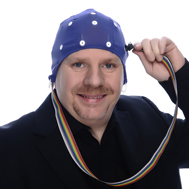Neurofeedback
Neurofeedback is a non-invasive way of training the brainwaves.

By Tony Steffert
Neurofeedback is an established therapeutic learning intervention in use since the 1950s, in which a participant’s own EEG parameters (Brainwaves) are presented back to them in real-time to facilitate the learning of control of their own physiology via this feedback loop. This enables people to learn how to change their physiological activity for the purpose of improving health and performance (Sterman, 2000).
Neurofeedback has been classified by a joint taskforce of the Association for Applied Psychophysiology and Biofeedback (AAPB) and the International Society for Neurofeedback & Research (ISNR) as “efficacious” or “efficacious and specific” for several conditions (Yucha and Gilbert, 2004), including ADHD (Arns et al., 2009), and generalized anxiety disorder (Rice et al., 1993).
Neurofeedback has also been applied in other areas for which clinical evidence is not so well established yet, such as epilepsy (Sterman, 1972), dyslexia (Steffert, T., & Steffert, B. (2016). EEG, ERP and Neurofeedback. Handbook of Clinical QEEG and Neurotherapy, 213.), sleep problems (Hoedlmoser et al., 2008), autism, headaches, anxiety, insomnia, substance abuse, pain disorders and traumatic brain injury (Thomas and Smith, 2015).
“the absence of evidence, is not evidence of absence”
The feedback is typically given on a computer screen in the form of a Bar graph or line chart that reflects the amplitude of a given EEG frequency band, or in the form of a game-like display, where the EEG controls the behaviour or appearance of the game (Hammond, 2007). For example, if a person was able to sustain their concentration, this would typically be characterised by an increase in EEG Beta power (15 to 18 Hz), while Theta power (4 to 8 Hz) would typically decrease in the front of the brain. When the Beta and Theta crossed a pre-set amplitude threshold, a computer graphic of a rocket ship could be programmed to start to move, and the sound of the engines to play. If the participant’s concentration waned, then the Beta would drop below the threshold and the rocket ship would stop.
In order to make a lasting change in symptoms or physiology neurofeedback typically requires between 10 and 40 training sessions, each of around 20 to 40 minutes (Hammond, 2007).
“Neurofeedback based on Neuroplasticity and Operant conditioning”
Operant conditioning (Skinner, 1938) is generally proposed as both the initial and primary mechanism for learning with neurofeedback (Hammond, 2007). Operant conditioning uses feedback and reward to modify voluntary behaviours. According to the theory of operant conditioning, there are three critical factors in determining how effective a reward will be in the conditioning feedback loop. The first is the immediacy of the feedback signal: the quicker the feedback, the shorter the learning time and the more rewarding the experience. Conversely, as the time between the behaviour and the reward is increased, known as “reinforcement delay”, learning efficiency is decreased. The second factor is the contingency of the signal; this refers to how accurately or fully the signal represents the activity being trained. And finally saliency refers to how rewarding the reward is to the participant (Skinner, 1950).
Neurofeedback is generally considered to be based on two concepts. Firstly, the activity of the brain in both normal and abnormal functioning is objectively reflected in the EEG (Sterman, 1996; John et al., 1988). Secondly, Neuroplasticity of the brain allows behaviour to be modified by learning (Demarin et al., 2014).
Numerous studies from Pavlov (Pavlov, 1927) and Skinner (Skinner, 1953) have elucidated the mechanism referred to as conditioning and calculated how, when, and for how long, an animal or human can be induced to make a lasting change in behaviour.
Both positive and negative conditioning have been codified into a reliable theory that is the basis of much psychology and ethology (Gray, 1970). However in clinical settings usually only positive reward is used in neurofeedback in order to encourage aberrant EEG towards a more normal state (Kluetsch et al., 2014; Birbaumer et al., 2013).

The Feedback Loop
The International Society for Neurofeedback and Research maintains a comprehensive bibliography on scientific papers published in the area of neurofeedback: Link
